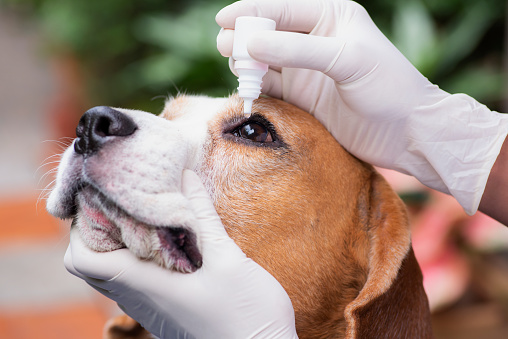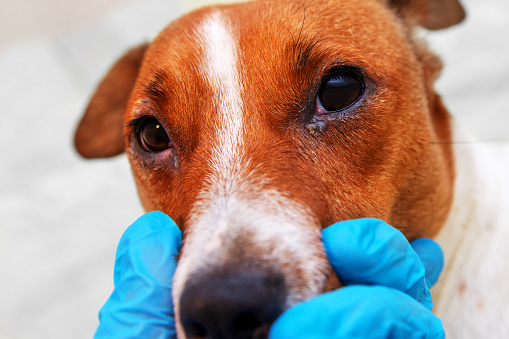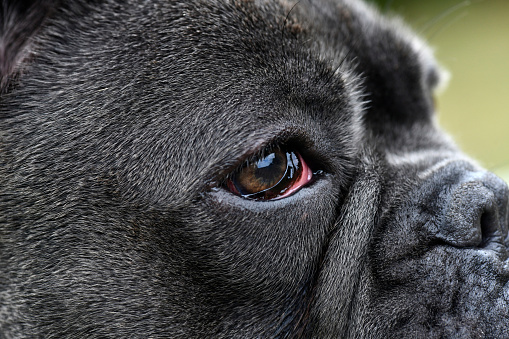
Keeping track of our dog’s health is something owners should never neglect. It is our responsibility to supervise our paw friends and make sure that they are safe and not exposed to potentially harmful situations.
Monitoring our dogs will help us determine if a problem may have occurred. Our paw friends’ eyes are an unprotected part of their bodies, exposed to environmental influence. Eye discharge is a common issue in dogs that might be caused by different factors and requires timely action.
Causes of Eye Discharge in Dogs
Physical Factors
Eye discharge may be caused by harmless factors, such as high wind or dust getting in your dog’s eyes. If you notice that the eye discharge is clear and watery, a foreign body in the eye may have caused it, i.e. an eyelash. If you notice that the discharge is more greenish/yellowish and looks like mucus (not so watery), it may be caused by an infection.
Glaucoma
Watery eyes may also be a symptom of Congenital Glaucoma. Glaucoma is a condition caused by either blocking the channel that the eye fluid (the so-called aqueous humor) goes through or by producing too much fluid. In the first case pressure in the eye builds up as the fluid can not drain properly.
Dry Eye
Tears help eyes get cleared and the inability of the body to produce enough tears may lead to a condition called Dry Eye. Symptoms of dry eye can be pus-alike discharge, which is more adherent, and inflammation.
Dry Rye may be caused by an autoimmune disease (the immune system attacks the glands producing tears), an injury, i.e. a bang on the head near the gland responsible for tear producing, as well by distemper.
Due to lack of lubrication and nourishment of the eyes, further complications such as infection and corneal ulcers may occur.
Conjunctivitis
Conjunctivitis, also known as Pink Eye, is infection or an inflammation of the membrane (conjunctiva) that lines the eyelid and the eye surface. Symptoms of this condition can be eye discharge, mucus, redness, itching, crusty eyes or excessive blinking. The causes of conjunctivitis may include: allergies, injury, foreign body, distemper...etc.
Epiphora
This condition is characterized by excessive tearing from the eyes onto the face and can be caused by different factors such as allergies, inflammation, corneal ulcers...etc.
Corneal Ulcers
Open sores on the cornea, known as corneal ulcers, are usually caused by infection (bacterial, viral, fungal or parasite) and are accompanied by redness, eye pain, mucus or other eye discharge as well as eye sensitivity. The sores can affect the eye on the surface or more deeply.

Difference Between Bacterial and Viral Infections
Bacteria are celled organisms, that can survive on their own whether inside or outside the human body.
Viruses, on the other hand, are not made of cells, but of a set of genes, put together within a protective protein shell. Viruses, unlike bacteria, need a host to multiply.
As the names of the two types of infection imply, the first one is caused by bacteria, while the second one is caused by viruses. It is important for both types to be distinguished as this affects the treatment. While bacterial infections are usually treated with antibiotics, these are not effective against viruses. Using antibiotics against viral infections may worsen the problem and lead to antibiotic resistance.
Foreign bodies such as eyelash, dust, scrap, plant material, as well as specific features of the eyes, like eyelids that grow inward/outward, may lead to a bacterial infection.
Viral infection, on the other hand, may be caused by a canine distemper virus.
Most Common Symptoms of Eye Infection
Besides eye discharge there are other symptoms of an eye infection, that may include:
- Excessive blinking
- High sensitivity
- Redness
- Swelling of the eyelids
- Pawing at the infected eye
When an infection is present, inflammation is likely to occur as a natural response of the immune system.
Some symptoms are common for more than one condition, so it is important that you do not take any actions prior to knowing for sure what the exact health condition is.

How to Treat Eye Infection at Home
It is highly recommended that you consult your dog’s veterinarian first and let your dog undergo examination. Eye drops or salves are likely to be prescribed and these may need to be applied to the infected eye in a home environment.
Prior to applying the prescribed medication, you should gently clean the eye discharge from your dog’s face. You can use a moist warm towel or a cotton bowl.
If you are applying eye drops, you should push your canine’s head back very gently and try to keep it in position. This is important in order to ensure that you will not harm your dog’s eye if he/she rapidly moves.
If you are applying a salve, you should pull your dog’s lower lid so that space for the salve opens. You should be very careful and affectionate and make sure that you will not injure your canine, if he/she moves. Put your hand on his/her head to ensure that it will remain in the same position. After you have applied the salve, you should open and close your dog’s lids a few times, so that the salve can be distributed to all areas inside the eye.
Besides eye drops and a salve, antibiotics may also be prescribed.
In certain cases, your dog may need to undergo an operation.
Should You Try Removing a Foreign Body from Your Dog’s Eye Yourself?
In general, we would say it depends. If the foreign body is visible, easy to access, and your intervention will not cause pain or worsen the problem, then yes. If the foreign body is not easy to access and special tools will be required, you may want to leave this job to a veterinarian. You should not take any actions that you are not sure will affect your dog’s health.
Breed Predisposition to Eye Discharge
Breeds with the following features are considered more prone to eye discharge and eye infections in general:
- Short-muzzled breeds with flattened faces (the so-called brachycephalic breeds) such as the Pug, the Bulldog, the Shih Tzu, the Pekinese, Cavalier King Charles Spaniel, the Boxer, the Boston Terrier;
- Breeds with wrinkled loose facial skin such as Saint Bernard, Bloodhound, Beagle...etc.
Eye Infections Prevention
Since our paw friends have a natural instinct to explore their environment, it might be difficult for us to make sure that they will never get infected. However, you still can take preventive actions such as:
- Regular grooming
That way you will make sure that the hair around their eyes is trimmed, and it will not irritate the eyes.
- Goggles
For many of you having your paw friend wear goggles may sound a bit odd or fancy. However, wearing goggles can be very beneficial for your dog, as they will protect his/her eyes, especially in situations such as: riding on a motorcycle, visiting a winter resort, going to the beach...etc…
- Regular cleaning
During bathing or on a regular basis, you should take care of your dog’s eyes and gently clean them with warm water.
- Use the right hygiene supplies
Always use shampoos specially designed for dogs and protect your paw friend’s eyes during bath time.
- Veterinarian checks
Do not neglect regular veterinarian checks as you will be able to take action in a timely manner if any underlying health issues might be present.
- Monitor your dog
Supervising your dog will help you recognize any symptoms such as redness or eye discharge. Also, you will be able to determine if there are any deviations from his/her normal behavior, such as too much blinking or pawing at the eye.












